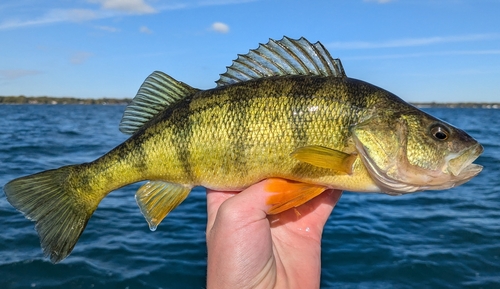
Yellow Perch
The Bluefin Tuna, a majestic and powerful fish, is renowned for its incredible speed, size, and endurance. It's a highly migratory species, traversing vast oceanic distances. This fish holds significant cultural and economic value, especially in culinary traditions, while also facing considerable conservation challenges due to its popularity.
9 11 years
Lifespan
10 - 25 cm
Length
Least Concern
Conservation Status
10 km/h
Swimming speed
Insectivorous, Carnivorous
Diet
Local Migration
Migration
Appearance Overview
The Bluefin Tuna is renowned for its large, streamlined body, built for speed and endurance in the open ocean.
Color
Dark metallic blue on top, with a silvery-white underside
Fins
Two dorsal fins, the first depressible; small, yellow finlets run down the back and belly
Body Shape
Torpedo-shaped, designed for efficient swimming
Length
Up to 10 feet (3 meters) on average, can reach up to 13 feet (4 meters)
Weight
Typically around 550 lbs (250 kg), but can exceed 1,500 lbs (680 kg)
Diet
Carnivorous, feeding on a variety of fish, squid, crustaceans, and eels.
Feeding Behavior
Highly active predators, Bluefin Tuna use their speed and agility to chase down prey. They often hunt cooperatively, corralling smaller fish into tight balls.
Social Behavior
Highly migratory and known to form large schools, particularly during spawning season. Schooling behavior varies with age, size, and feeding habits
Commercial Relevance
Extremely high value, especially in sushi and sashimi markets, where it is considered a delicacy. This demand has driven premium prices, particularly for the fattiest cuts (toro).
Conservation measures
International fishing quotas, size limits, and seasonal closures are in place to manage Bluefin Tuna stocks. Efforts include tagging programs to monitor populations and migration patterns.
Status
Varies by species: Atlantic Bluefin Tuna (Endangered), Pacific Bluefin Tuna (Near Threatened), Southern Bluefin Tuna (Critically Endangered).
Threats
Overfishing remains the primary threat. Other factors include bycatch in fishing gear, habitat degradation, and climate change affecting prey distribution and spawning grounds
Habitat Distribution
Depth Range
Surface waters down to depths of over 3,000 feet (900 meters), depending on the species and location.
Geographic Range
Atlantic Bluefin Tuna: Western and Eastern Atlantic, Mediterranean Sea. Pacific Bluefin Tuna: North Pacific Ocean. Southern Bluefin Tuna: Southern Hemisphere oceans.
Preferred Environment
Primarily pelagic, inhabiting temperate and subtropical waters. They are highly migratory, often associated with oceanic currents and temperature fronts
Reproduction and Life Cycle
Breeding Habits
Spawns in warm waters, with major spawning grounds including the Gulf of Mexico and the Mediterranean Sea. Spawning typically occurs during specific seasons.
Development Stages
Eggs are released and fertilized in open water. Larvae are planktonic, drifting with currents. Juveniles grow rapidly, forming schools and gradually adopting adult migratory behaviors.
Fecundity
Females are highly fecund, capable of releasing millions of eggs per spawning season, enhancing reproductive potential despite high natural mortality.
Maturity Age
Atlantic Bluefin Tuna mature at around 4-8 years, while Southern Bluefin Tuna mature later, around 8-12 years. Pacific Bluefin Tuna maturity varies.
Faqs about Yellow Perch
How fast can Bluefin Tuna swim?
Bluefin Tuna are among the fastest fish in the ocean, capable of reaching speeds up to 43 mph (70 km/h) in short bursts.
Are Bluefin Tuna warm-blooded?
Bluefin Tuna have a specialized circulatory system that allows them to maintain a body temperature higher than the surrounding water, aiding in muscle efficiency and speed.
Do Bluefin Tuna migrate?
Bluefin Tuna undertake extensive migrations across oceans for feeding and spawning, often traveling thousands of miles.
Is it okay to eat Bluefin Tuna?
Yes, but it's crucial to choose Bluefin Tuna from sustainable sources, if available, due to overfishing concerns.
How long do Bluefin Tuna live?
The lifespan of Bluefin Tuna can vary, but they are known to live up to 15-30 years, with some potentially living even longer.
Copyright @ Nature Style Limited. All Rights Reserved.
 English
English